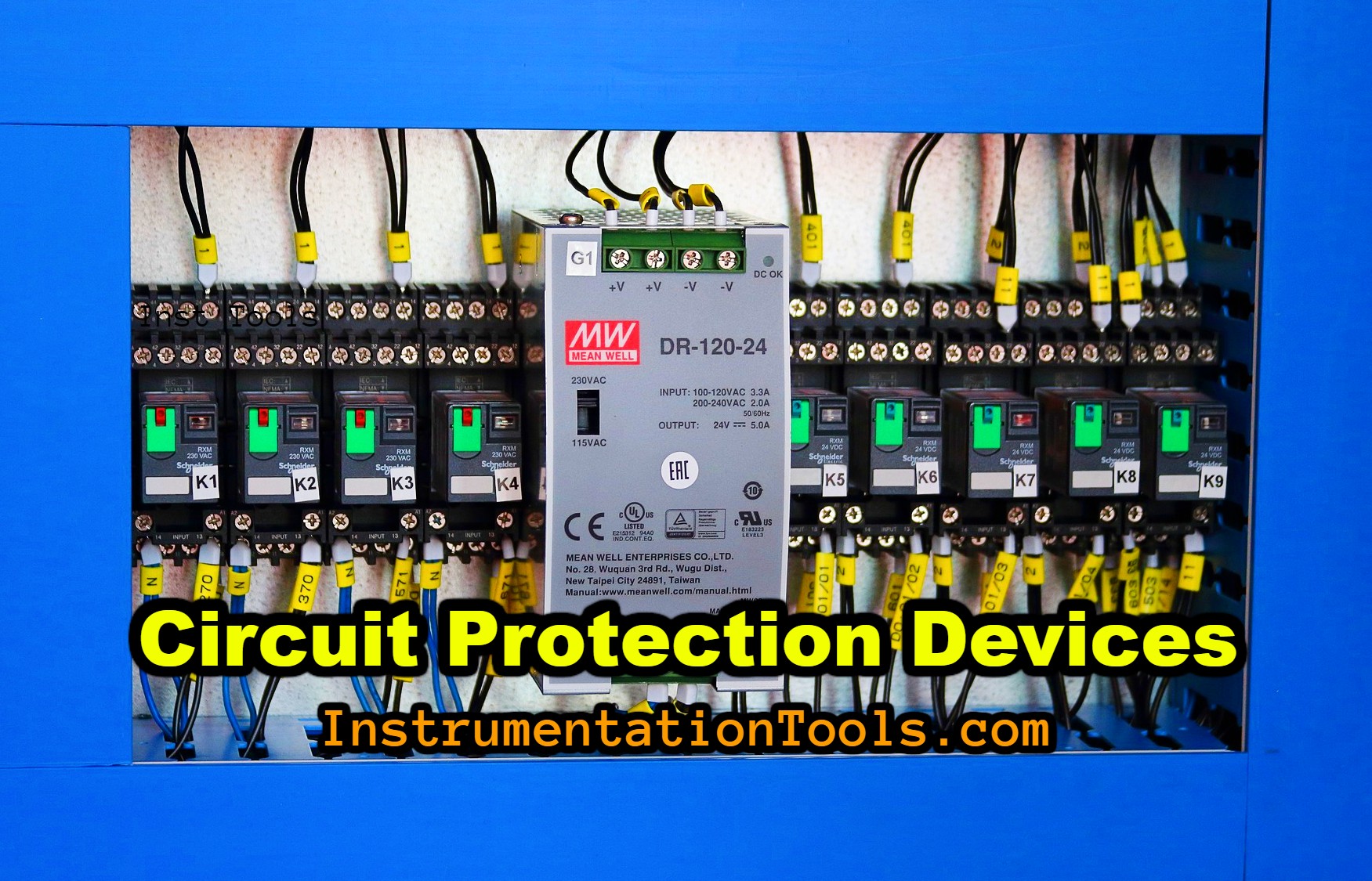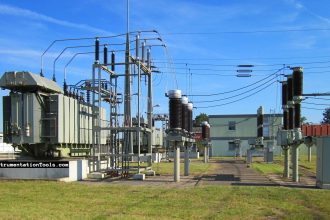In this article, you will find the circuit protection devices’ objective questions and answers for instrumentation, electrical, and electronics engineers.
Circuit Protection Devices Questions

The below list provides all the multiple-choice questions (MCQ) related to the circuit protection devices.
Answers are available at the bottom of the article.
1. Selective tripping is used to accomplish which of the following purposes?
| A) | To enable the application of power to emergency circuits during an overload |
| B) | To simplify the task of resetting the circuit breaker |
| C) | To reduce wear and tear on circuit breakers |
| D) | To isolate a faulty circuit without affecting other circuits |
2. A fuse current rating has which of the following definitions?
| A) | The maximum current that can flow through a circuit without causing the circuit to overheat |
| B) | The maximum current that will not”jump” an open fuse |
| C) | The maximum current that will flow through a fuse without opening the fuse |
| D) | The maximum current that will flow through a circuit if there is a direct short |
3. When a point in a circuit, where full system voltage is present, comes in direct contact with the ground or return side of the circuit, which of the following terms applies?
| A) | Excessive current |
| B) | Abnormal heating |
| C) | High resistance |
| D) | Direct short |
4. What is the current rating for a fuse with the designation F03B0R50B?
| A) | 3 amp |
| B) | 50 amp |
| C) | 1.5 amp |
| D) | 1/2 amp |
5. Which of the following is NOT a safety precaution to be observed when a fuse is changed?
| A) | Remove any corrosion from the fuse-holder before replacing a fuse |
| B) | Be sure to “tag out” the fuse-holder when you remove the fuse |
| C) | Be sure the fuse fits properly in the fuse-holder |
| D) | Remove the power from a circuit before removing and replacing a fuse |
6. Which of the following methods will provide an ABSOLUTE determination as to whether or not a fuse is open?
| A) | A voltmeter check of the fuse |
| B) | A thermometer check of the temperature of the fuse |
| C) | A visual inspection |
| D) | A check of the fuse indicator |
7. Which of the following factors is NOT used to rate fuses?
| A) | Size |
| B) | Voltage |
| C) | Current |
| D) | Time delay |
8. What is the voltage rating for a fuse with the designation F02B250V10AS?
| A) | 10 V or less |
| B) | 250 V or less |
| C) | 52 V or less |
| D) | 32 V or less |
9. Before replacing a fuse, you should check for which of the following conditions?
| A) | Proper input voltage |
| B) | Proper fit |
| C) | Both Proper fit and Proper fuse |
| D) | Proper fuse |
10. What is the new military designation for a fuse with the old, military designation F03D1R50B?
| A) | F03A125V1.5A |
| B) | F03A250V11/2A |
| C) | F03B125V1.5A |
| D) | F02B125V1.5A |
11. Selective tripping is used to cause which of the following circuit breakers to trip when there is an overload?
| A) | The least expensive |
| B) | The smallest current rating |
| C) | The closest to the fault |
| D) | The most accessible |
12. How are circuit protection devices connected to the circuit they are protecting?
| A) | In series-parallel |
| B) | In parallel |
| C) | In series |
| D) | Alongside |
13. What is the current rating for a fuse with the designation F03A125V5A?
| A) | 125 amp |
| B) | 3 amp |
| C) | 5 amp |
| D) | 1/8 amp |
14. What is the time-delay rating for a fuse with the designation F04C125V2AS?
| A) | Fast |
| B) | Delay |
| C) | Intermediate |
| D) | Standard |
15. What is the voltage rating for a fuse with the designation F03D1R00B?
| A) | 250 V or less |
| B) | 32 V or less |
| C) | 125 V or less |
| D) | 500 V or less |
16. What is the voltage rating for a fuse with the designation AGC5125V?
| A) | 25 V or less |
| B) | 12 V or less |
| C) | 125 V or less |
| D) | 51 V or less |
17. Which of the following two are circuit protection devices?
| A) | Electrical plugs and CO2 cartridges |
| B) | CO2 cartridges and circuit breakers |
| C) | Fuses and circuit breakers |
| D) | Fuses and electrical plugs |
18. Circuit protection devices are used for which of the following purposes?
| A) | To protect circuits |
| B) | To guard against hazardous conditions |
| C) | All of these answers |
| D) | To protect people |
19. A fuse is removed from a circuit, checked with an ohmmeter, and found to be shorted. What action should be taken?
| A) | Check the fuse with a voltmeter |
| B) | Return the fuse to the supply department |
| C) | Discard the fuse |
| D) | Put the fuse back in the circuit |
20. What is the current rating for a fuse with the designation 3AG1032V?
| A) | 1 amp |
| B) | 10 amp |
| C) | 2 amp |
| D) | 3 amp |
21. What is the total number of main components in a circuit breaker?
| A) | Five |
| B) | Three |
| C) | Two |
| D) | Four |
22. What is the current rating for a fuse with the designation F03A125V5A?
| A) | 125 amp |
| B) | 1/8 amp |
| C) | 5 amp |
| D) | 3 amp |
23. What is the time-delay rating for a fuse with the designation F03A20R0C?
| A) | Standard |
| B) | Fast |
| C) | Intermediate |
| D) | Delay |
24. What is the time-delay rating for a fuse with the designation F03A20R0C?
| A) | Delay |
| B) | Fast |
| C) | Intermediate |
| D) | Standard |
25. If the bearings of a generator were to fail, which of the following circuit conditions would probably occur?
| A) | Excessive current |
| B) | Abnormal heating |
| C) | High resistance |
| D) | Direct short |
26. What is the current rating for a fuse with the designation AGC2125V?
| A) | 3 amp |
| B) | 2 amp |
| C) | 25 amp |
| D) | 1 amp |
27. What is the voltage rating for a fuse with the designation F02B250V10AS?
| A) | 10 V or less |
| B) | 250 V or less |
| C) | 32 V or less |
| D) | 52 V or less |
28. When you perform preventive maintenance on fuses, which of the following is NOT a condition you should check?
| A) | Improper fit |
| B) | Shorted fuse |
| C) | Corrosion |
| D) | Improper fuse |
29. What is the current rating for a fuse with the designation 3AG1032V?
| A) | 1 amp |
| B) | 10 amp |
| C) | 3 amp |
| D) | 2 amp |
30. When circuit current increases beyond the designed current carrying capability of the circuit, which of the following terms applies?
| A) | High resistance |
| B) | Direct short |
| C) | Abnormal heating |
| D) | Excessive current |
31. What is the voltage rating for a fuse with the designation 3AG20125V?
| A) | 90 V or less |
| B) | 250 V or less |
| C) | 125 V or less |
| D) | 20 V or less |
32. The following actions must be taken prior to working on a circuit breaker.
Arrange these items in the proper sequence, then select the choice below that lists the events in the proper sequence.
A. Tag the power switch
B. Obtain the approval of the electrical officer
C. Remove power to the circuit breaker
D. Check the applicable technical manual
| A) | D, B, C, A |
| B) | B, A, D, C |
| C) | C, B, D, A |
| D) | A, B, C, D |
33. Which of the following methods should be used to check a .002 ampere fuse?
| A) | Use a megger and place a capacitor in parallel with the fuse |
| B) | Use a megger and place a capacitor in series with the fuse |
| C) | Use an ohmmeter and place a resistor in parallel with the fuse |
| D) | Use an ohmmeter and place a resistor in series with the fuse |
34. A fuse voltage rating has which of the following definitions?
| A) | The maximum voltage that can exist in a circuit if there is a direct short |
| B) | The maximum voltage across a fuse that will not jump the open fuse |
| C) | The maximum voltage across a fuse that will not cause the fuse to open |
| D) | The maximum voltage that can exist in a circuit without causing the circuit to overheat |
35. Which of the following is NOT a time-delay rating for a circuit breaker?
| A) | Long |
| B) | Short |
| C) | Instantaneous |
| D) | Standard |
36. Which of the following items is NOT checked during maintenance on a circuit breaker?
| A) | Operating mechanism smoothness |
| B) | Input power voltage |
| C) | Terminal tightness and corrosion |
| D) | Contact surfaces for pitting |
37. What should you use to remove a fuse from a clip-type fuseholder?
| A) | A pair of pliers |
| B) | A scribe |
| C) | A fusepuller |
| D) | A screwdriver |
38. What is the time-delay rating for a fuse with the designation F04C125V2AS?
| A) | Delay |
| B) | Intermediate |
| C) | Standard |
| D) | Fast |
39. Which of the following is NOT a type of trip element for a circuit breaker?
| A) | Thermal |
| B) | Mechanical |
| C) | Thermal-magnetic |
| D) | Magnetic |
40. Which of the following is a safety precaution to be observed when a fuse is checked?
| A) | When you check a fuse with an ohmmeter, be careful to avoid short circuits |
| B) | All of these answers |
| C) | When you use a voltmeter to check a low current fuse, be careful to avoid opening the fuse by excessive current from the voltmeter |
| D) | Turn the power off and discharge the circuit before the fuse is removed |
41. A circuit breaker that will trip even if the operating mechanism is held ON is known as what type of circuit breaker?
| A) | Non-trip free |
| B) | Emergency |
| C) | Trip free |
| D) | Standard |
42. What type of circuit breaker can be overridden if the operating mechanism is held ON?
| A) | Emergency |
| B) | Non-trip free |
| C) | Standard |
| D) | Trip free |
43. What is the voltage rating for a fuse with the designation 3AG20125V?
| A) | 125 V or less |
| B) | 20 V or less |
| C) | 90 V or less |
| D) | 250 V or less |
44. Which of the following conditions does NOT require the use of a circuit protection device?
| A) | High resistance |
| B) | Excessive current |
| C) | Direct short |
| D) | Abnormal heating |
Click Here for Answers
If you liked this article, then please subscribe to our YouTube Channel for Electrical, Electronics, Instrumentation, PLC, and SCADA video tutorials.
You can also follow us on Facebook and Twitter to receive daily updates.
Next Quiz:
- Electronics Questions
- Electrostatics Questions
- Rectifiers & Converters MCQ
- Ohms Law Objective Questions
- Transmission and Distribution Quiz















